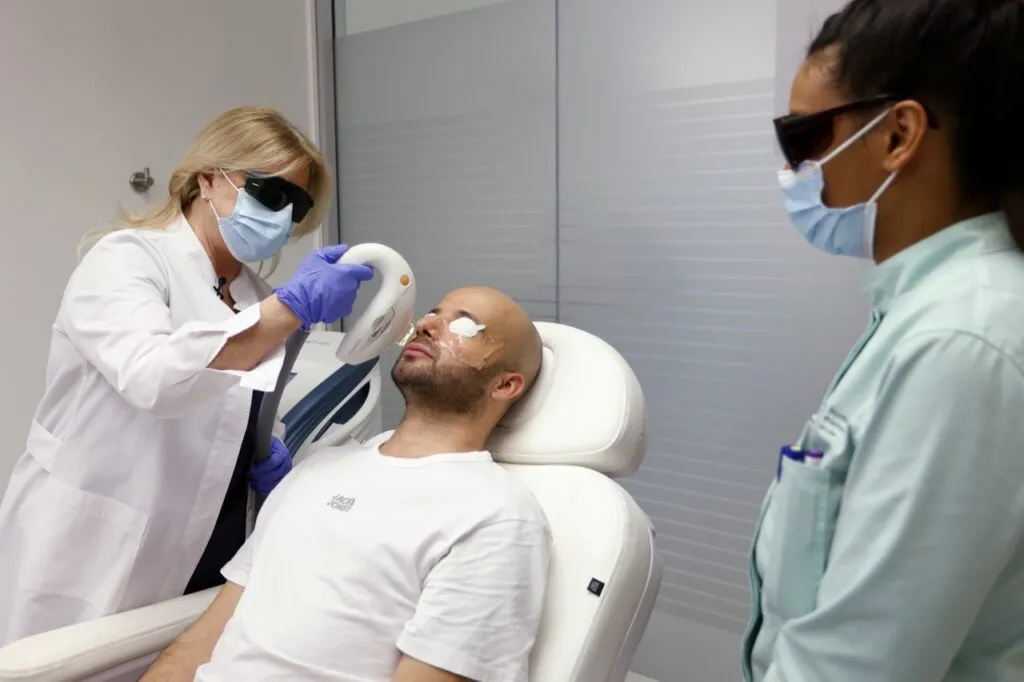
Treatment of dry eye syndrome with IPL
Dry eye syndrome is the most frequent disease in ophthalmology and particularly affects people of a certain age, despite also appearing in youngsters. The discomfort stemming from the condition can affect the quality of life of patients and includes stinging, itching and even the loss of visual acuity. Luckily, there are now different treatments for dry eye syndrome with high success rates. One of the most effective is Intense Pulsed Light or IPL treatment, an extremely safe anti-inflammatory treatment.
What is dry eye syndrome?
Dry eye syndrome occurs when, as a result of less blinking, there is decreased contraction of the orbicularis oculi muscle, which also leads to a reduction in the secretion of an oil that is essential in the correct production of tears. Without an optimal amount of this oil, tears evaporate too quickly and the eyes do not receive the necessary hydration to remain healthy and fully functional. In other words: less blinking leads to a chain reaction that ends up altering the natural physiology of the eyes. It is this alteration that leads to the negative symptoms of dry eye that patients find so difficult to endure.
The causes of the syndrome, which is one of the most common questions asked by patients, are multifactorial: dry atmospheres caused by air-conditioning units, hormonal problems or taking certain medication can trigger this chain reaction. However, one cause that is present in almost all cases of dry eye, and which often has the most impact, is the excessive use of electronic displays. This is the reason why dry eye disease is often known as the 21st-century disease. At the end of the day, we spend hours and hours looking at our mobile phones and computers.
What is IPL (Intense Pulsed Light)?
Intense Pulsed Light is a non-invasive phototherapy technology used in different sectors. In dermaesthetics, for example, it is used to treat skin conditions, such as hyperpigmentation or vascular lesions. In ophthalmology, which is our field of work, it is used to heat and influence the blood vessels located on the edges of the eyelids. This improves the eye health of patients with disorders, such as blepharitis, ocular rosacea or dry-eye syndrome itself. Furthermore, the good news is that it can be used for people of all ages and with any condition, except for particular cases of specific medication.
How is IPL used to treat dry eye?
During the procedure, a conductive gel is applied to the patient’s eyelids and advanced pulse technology is used to apply the high-intensity light pulses to their edges. This light is absorbed by the conducts of the Meibomian glands, which are responsible for producing the natural oils that ensure tears do not evaporate and the eyes remain hydrated. It is an anti-inflammatory procedure that is almost 100% effective and completely safe, making it a key alternative in treating dry eye syndrome. But it rarely consists of just one session. It is a longer treatment.

Duration of IPL treatment for dry eyeel ojo seco
Several sessions are generally required to decrease inflammation and correct the dysfunction of the Meibomian glands. The precise amount depends on each patient and their circumstances, which are analysed during the assessment stage before the first session, but it is frequently around four sessions. As a specialist who has performed over one thousand IPL interventions for dry eye syndrome, I can say that most patients start to notice an improvement after the first session. This is extremely important for those who are used to putting up with extreme discomfort in their eyes. Considerable relief.
Benefits of treating dry eye with pulsed light
The main benefit of the treatment with Intense Pulsed Light for dry eye is its extreme effectiveness in correcting problems linked to the glands responsible for generating the lipid film that protects tears. However, other reasons, such as its safety and its non-invasive nature, mean that it is strongly advised by ophthalmology experts and is very well accepted by patients. All in all, the procedure requires no incisions, anaesthesia or recovery, and people can go back to their normal lives immediately after the sessions. What is more, its effects can last months and even years.
Does treating dry eye with IPL have any side effects?
The Intense Pulsed Light treatment causes no excessive discomfort in patients and enables them to return to their normal lives once completed. However, like any medical treatment, IPL may have certain very minor side effects, such as temporary reddening of the area treated, certain sensitivity to light or a slight burning sensation. In any case, these effects – should they appear – disappear within a few days, whereas the positive results of the intervention are long-lasting. In short, it is a treatment that gives millions of people hope for a normal life.